
It’s high summer in South Dakota, and a cruel sun beats down with an endless floodtide of photons that burns skin through t-shirts and tinted car windows. That’s the way Henry Red Cloud likes it. To Red Cloud — descendant of a great Lakota insurgent chief, founder of Lakota Solar, and self-proclaimed “solar warrior” — that July sun is key to the independence of his fellow Lakota and native peoples across America; it also embodies a hot business opportunity.
It’s July 5, the tail end of Red Cloud’s Energy Independence Day weekend, first announced in the wake of the Trump Inauguration, and meant to spread off-grid skills throughout Indian country — possibly with radical purpose.
I walked out of the sun and indoors to find Red Cloud leading a solar workshop, holding forth to a group of eager indigenous participants about photovoltaic cells and the danger of phantom loads — the way in which many appliances continue drawing current even when switched off. “Vampire” loads are a constant suck on household energy, consuming electricity and thereby emitting carbon to no purpose — while also draining an off-grid setup with limited juice.
A set up, like, say, the remote, off-grid camps at the Standing Rock Dakota Access Pipeline (DAPL) protests in 2016.
Red Cloud offers up a hypothetical: “Let’s say you have a Water Protector camp, your solar array is charging, you notice the inverter is on, but nothing is plugged in.” The stocky 60-something instructor, with long ponytail and far-seeing eyes, frowns and shakes his head, indicating trouble. “Well, that empty power strip can draw more than your actual daily use,” draining down the batteries faster than they can charge.”
A bearded man in his late 20s raises his hand. “That bad for the array?”
“Well,” Red Cloud responds, “it’s not a problem if you know about it. Just plug in a couple cellphones,” and charge them up so protestors can reach out to the media from the remote site. That way, he says, at least now the array is doing some work.
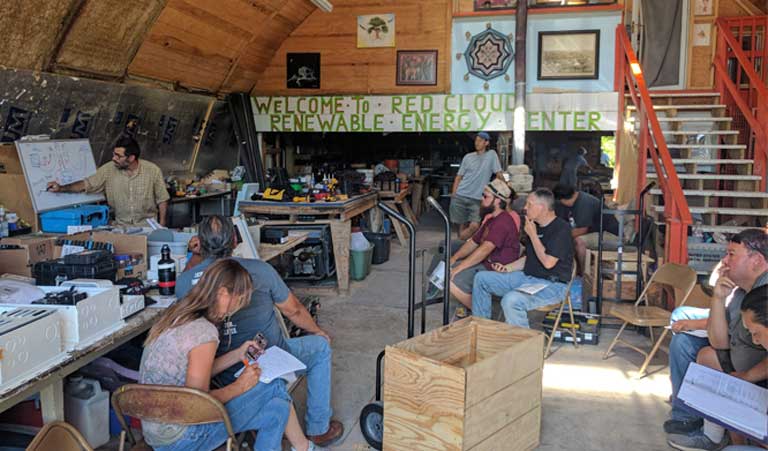
Man With a Plan
After the workshop, Red Cloud shows me his innovations. A solar trailer, small enough to be pulled by a compact car, is mounted with panels and an inverter. We step into a show-house built out of compressed earthen blocks — the hydraulic press that makes them runs on diesel, the only machine Red Cloud owns that depends on fossil fuel.
“And then there’s this,” he says, pointing to a plywood box with Plexiglas atop it, a 35V photovoltaic panel that sparkles in the sun. It’s a homemade solar furnace: in the brutal Dakota winter, it can generate a 190 degree Fahrenheit mass of air, along with enough energy to blow that warmth through a house, largely eliminating heating costs. He takes me to see the solar pumps that move running water through his two-story school building.Red Cloud’s training center and home is a model for something new and, not to put too harsh a word on it, revolutionary.
His compound represents an all-in-one alternative energy lab and off-grid resistance camp set in the middle of the Pine Ridge Indian Reservation. That’s a highly unlikely place for energy innovation: Pine Ridge is America’s second poorest county, a sprawling and desolate collection of about 40,000 spread across the South Dakota Badlands. Most locals are so impoverished, and so estranged from the cash economy, that some 60 percent of them can’t afford to hook up to the electric grid.
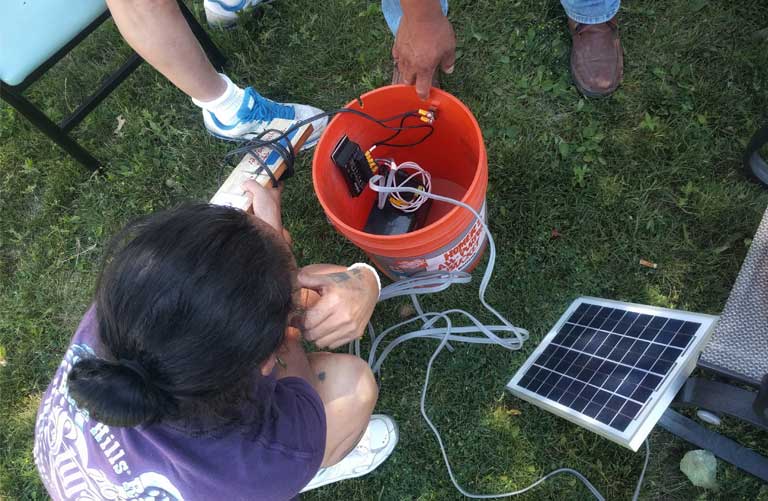 Gloria Red Cloud shows off a solar-powered floodlight she built for her car using about $100 in materials. (Photo: Saul Elbein)
Gloria Red Cloud shows off a solar-powered floodlight she built for her car using about $100 in materials. (Photo: Saul Elbein)
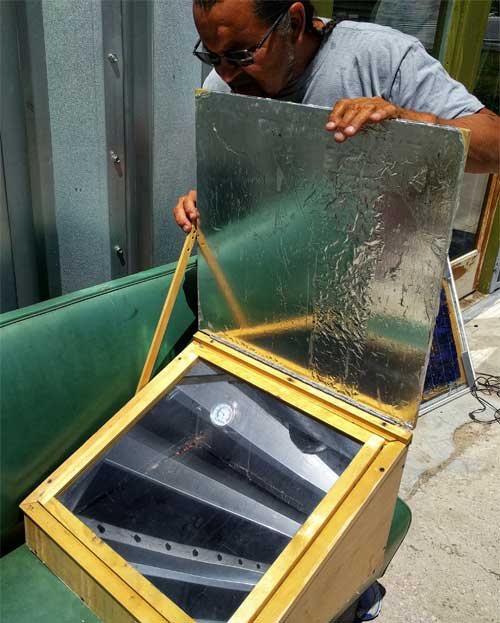 This solar furnace can generate a 190-degree mass of air, supplementing grid or wood heat in the brutal Dakota winter. (Photo: Saul Elbein)
This solar furnace can generate a 190-degree mass of air, supplementing grid or wood heat in the brutal Dakota winter. (Photo: Saul Elbein)
Which, to many Lakota leaders and especially Red Cloud, represents a huge opportunity — a chance for the tribe to leapfrog over the 20th Century energy economy of coal and natural gas burning power plants and regional transmission lines into a New Economy. The goal is to build an energy independent First Nation and modern lifestyle, beyond the reach of oil shortages, price hikes, and the environmental harm perpetuated by the U.S. fossil fuel-driven economy.
For more than a decade, Red Cloud has been running Lakota Solar, an off-grid skills school and solar machine factory — one of Pine Ridge’s few locally owned business, and the heart of a business network that extends to a dozen other reservations.
Over a thousand alumni have learned to build solar arrays, solar furnaces and solar-driven water pumps in his schools. To Red Cloud, these are practical skills that expand people’s economic and political options. But they’re also something mystical — a key to a new personal and communal future. The two of us settle under a shade tree, and Red Cloud declares: “Number 45,” (that being his way of referring to U.S. President Donald Trump) “is changing a whole lot in our country. So we need to start banding together, natives and non-natives, and if we’re going to build this country let’s build it efficient.”
He wipes his forehead. “We’re all waiting for something. What? I don’t know. But it’s time to get started,” he says.
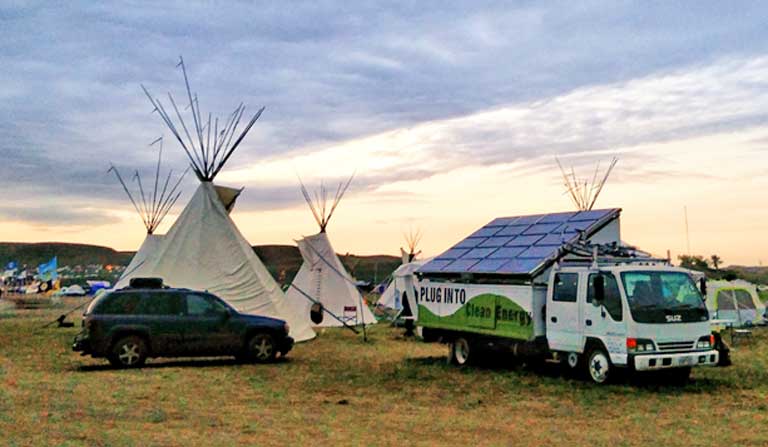 Portable solar arrays helped power the Oceti Sakowin Camp, which rose on the north end of the Standing Rock Reservation in the summer and fall of 2016 in opposition to the Dakota Access pipeline. Though primarily powered by wood and gasoline, the camps also ran on a great deal of solar. (Photo: Saul Elbein)
Portable solar arrays helped power the Oceti Sakowin Camp, which rose on the north end of the Standing Rock Reservation in the summer and fall of 2016 in opposition to the Dakota Access pipeline. Though primarily powered by wood and gasoline, the camps also ran on a great deal of solar. (Photo: Saul Elbein)
An Independent Tradition
In the early 2000s, Henry Red Cloud came home to the Pine Ridge Reservation and realized he had a problem. He’d spent years on the road, working seasonal construction, building with structural steel, interlocking the bones of skyscrapers “high above 5th Avenue” in New York City, and elsewhere, seeing much of America. But that wasn’t the world he wanted to live in.
“I had all these hopes of going home, having a job, getting to spend quality time with my people,” he recalls.
The word “home” for Red Cloud, and his moniker too, resonate with historic cadences. He is named for his five-times great-grandfather, the war-chief Red Cloud of the Oglalla Sioux. Though not a member of one of the traditional Oglalla ruling families, the original Red Cloud led a highly successful insurgency from 1866-1868 to prevent U.S. expansion into the productive buffalo grounds that the Lakota were then seizing from the Crow Indians.
During that conflict — now remembered as the Powder River War or Red Cloud’s War — the Oglalla and their Cheyenne and Arapahoe allies, defeated a number of U.S. expeditionary forces, wiping out an 81-man cavalry unit in the worst American military defeat at the hands of Plains Indians up to the defeat of Custer’s 7th Calvary at Little Big Horn, Montana in 1876.
The end of Red Cloud’s War resulted in the federal government signing the Treaty of 1868, ceding a vast territory to the Lakota that made up much of what is now the U.S. Midwest. Red Cloud then agreed to settle the Oglalla at Pine Ridge, and his fight ended there. When in 1876 the Hunkpapas under Sitting Bull rose against the U.S. in anger at the treaty’s violation, the elder Red Cloud stayed out, seeing no benefit in further battles against the Americans.
The Oglallas have been at Pine Ridge since, renowned among the other Lakota and Dakota peoples for the extent to which they have proudly maintained their culture. It is still common to meet elderly Oglalla who speak only their tribal language well, and English with difficulty.
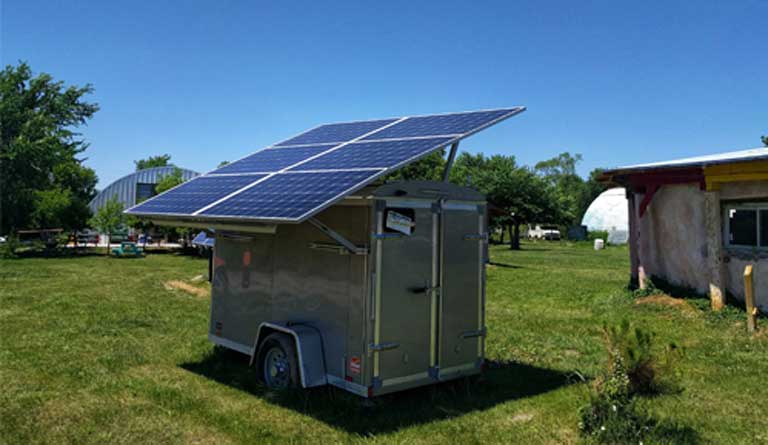 One of the portable solar trailers that Red Cloud brought to Standing Rock. (Photo: Saul Elbein)
One of the portable solar trailers that Red Cloud brought to Standing Rock. (Photo: Saul Elbein)
Here Comes the Sun
According to Henry Red Cloud, what the Oglallas lack today, and badly need, is a thriving economy. When he came home in 2002, he found a reservation that relied on something roughly comparable to a colonial economy — indigenous settlements were largely dependent on franchise stores and chains that brought little money into the community, but which sucked out dollars to the benefit of faraway corporate headquarters. About the only jobs on the reservation were with the tribe — as police, in schools and government.
With the initial intention of just making some cash, Red Cloud signed up for a solar installation course. It was a revelation.
“I thought, as natives we’ve been embracing the sun for eons,” he says, offering the Sundance as an example, the most sacred rite of the Plains Indians, in which devotees dance ecstatically for four days, exposed to the elements, without sleep, food or water.
“We have always believed in living off the land,” he says. After graduating from that first solar course, he decided there was no reason that this native self-sufficiency shouldn’t be reestablished.
He took more solar courses, learned more about alternative energy and green technology. He started working as a solar installer, always expecting to run into other Native Americans who had enjoyed the same epiphany he had. “But there weren’t any,” he recalls.
“I encouraged my brothers to come [and learn from me], but people can’t just get up and [come to my workshops]. Everyone is doing something, like making handicrafts or gathering wild food, to help their families survive. They can’t leave their families for 19 days. So I thought, what if I bring this knowledge here, to Indian Country?”
By 2004, he had learned solar installation; by 2005 he was making his own solar machines; by 2006 he had founded Red Cloud Renewable Energy and was employing locals to make solar panels to sell to the other tribes. Meanwhile, his alternative energy training school began turning out graduates.
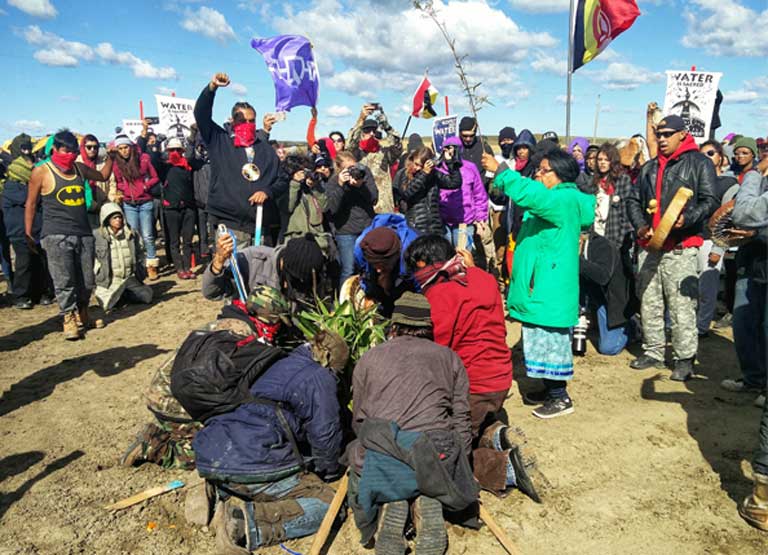 Water protectors planting cedar trees in the path of the Dakota Access pipeline in September 2016. Mounting an effective resistance opposition against pipeline projects in remote areas requires that activists be able to operate — and stay connected to the web. To Henry Red Cloud, off-grid solar is the ideal technology to meet that need. (Photo: Saul Elbein)
Water protectors planting cedar trees in the path of the Dakota Access pipeline in September 2016. Mounting an effective resistance opposition against pipeline projects in remote areas requires that activists be able to operate — and stay connected to the web. To Henry Red Cloud, off-grid solar is the ideal technology to meet that need. (Photo: Saul Elbein)
Finding an Alternative to the Devil’s Choice
For Red Cloud, solar and renewable energy are to the New Economy what the sun is to an intact ecosystem — the basis of everything, offering perpetual sustenance. A place as “underdeveloped” and remote as Pine Ridge, he says, has always presented its First Nation inhabitants with a devil’s choice: either continue in poverty, or sacrifice your culture to the world coming in from outside — usually the malls-and-suburban model of 20th Century America.
“But out here we’re rural,” Red Cloud says, pointing to the far horizon. “We’re the West of the West. At night you have a sky full of stars. You can see thunderstorms coming from 100 miles away. We have no Interstate, no banks, no nothing. And that’s how I like it — being able to go to the hills and see as far as the naked eyeball can see. I wouldn’t want to see mainstream America flood this place.”So, Lakota Solar and the Red Cloud Renewable Energy Center have become catalysts for an innovative economic network — one that employs locals and connects tribes, while building greater independence.
Ten years on, Red Cloud employs a dozen people at around $12 an hour, well above the U.S. minimum wage of $7.25 per hour. The products they make, they sell to other tribes, who add their own innovations to the mix. The nearby Rosebud Sioux have “gone to the next level,” says Red Cloud, installing residential-scale wind and rooftop solar. But they also buy their solar furnaces and photovoltaic arrays from Red Cloud. Lakota Solar is now the main supplier for three other native-owned small businesses — a solar-powered paper recycling company and two solar installation firms.
The alternative energy systems Red Cloud builds, and boosts, are what’s known as “grid-tie.” For now, they tie into the conventional electricity grid, providing a household, depending on its solar setup, with anywhere from 40 to 80 percent of their power. The systems are designed to be small scale and supplemental, offering a bit more power (or a bit more saved cash) to families that otherwise might go without, or fall short.
A mid-range residential setup from Lakota Solar goes for $3,500 and lasts about 30 years; that’s drastically below the $25 to $35 thousand dollar average cost for solar arrays found in the rest of residential America. His systems don’t pay the entire electric bill, Red Cloud says, “but it’s still money saved that goes back into the community. It’s enough to help build our own economy here.”
While not the be all, or end all, these inexpensive solar installations offer more than just extra electricity to High Plains reservations. For Red Cloud and other Native American leaders, these solar solutions possess a deep philosophical appeal, extending beyond economic or environmental motives, and extending into the communal, and even to the nearly spiritual.
“People don’t like being on the grid here,” Red Cloud says, “because they’ve been coexisting with the earth — the sun, the wind — for most of their history.” Clearly, the man who came back to the reservation in 2002 has found his way home, and he’s now bringing his people home too.
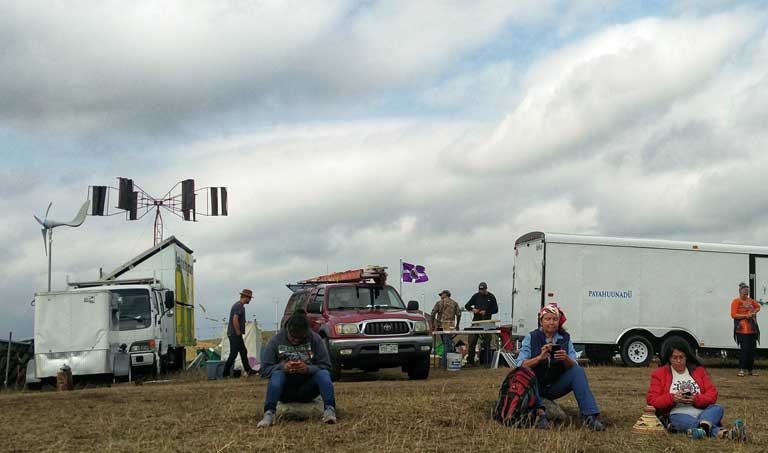 Campers at Oceti Sakowin in September 2016 sit on “Facebook Hill.” The height, being the highest point in the camp, was the only place to reliably receive the cell service that tied the water protectors to the rest of the world, including social media. Charging stations there used diverse forms of renewable energy including solar panels, bicycle generators or the windmill seen here in the background. (Photo: Saul Elbein)
Campers at Oceti Sakowin in September 2016 sit on “Facebook Hill.” The height, being the highest point in the camp, was the only place to reliably receive the cell service that tied the water protectors to the rest of the world, including social media. Charging stations there used diverse forms of renewable energy including solar panels, bicycle generators or the windmill seen here in the background. (Photo: Saul Elbein)
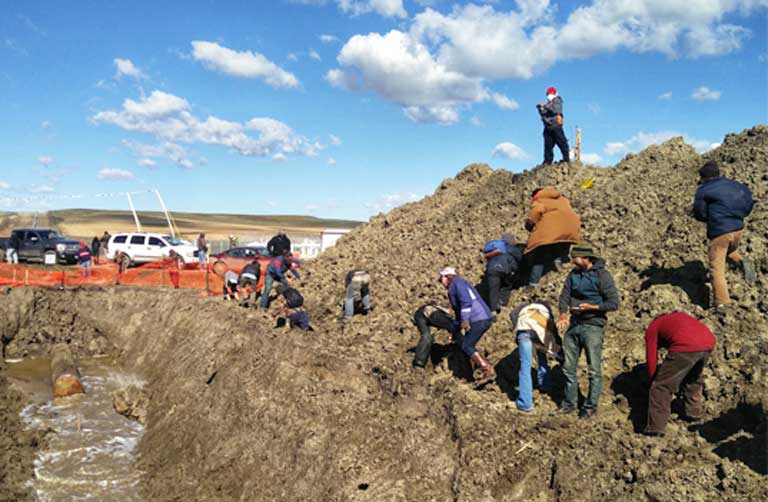 At an action in September 2016, activists threw rocks into a trench dug for the Dakota Access pipeline (DAPL). Building on the earlier anti-Keystone XL protests, the no-DAPL demonstrations often framed the fossil fuel economy as a “black snake” threatening the future of the world. Solar is seen as a way of breaking free of the grip of both oil and transnational energy companies. (Photo: Saul Elbein)
At an action in September 2016, activists threw rocks into a trench dug for the Dakota Access pipeline (DAPL). Building on the earlier anti-Keystone XL protests, the no-DAPL demonstrations often framed the fossil fuel economy as a “black snake” threatening the future of the world. Solar is seen as a way of breaking free of the grip of both oil and transnational energy companies. (Photo: Saul Elbein)
Join us in defending the truth before it’s too late
The future of independent journalism is uncertain, and the consequences of losing it are too grave to ignore. We have hours left to raise the $12,0000 still needed to ensure Truthout remains safe, strong, and free. Every dollar raised goes directly toward the costs of producing news you can trust.
Please give what you can — because by supporting us with a tax-deductible donation, you’re not just preserving a source of news, you’re helping to safeguard what’s left of our democracy.